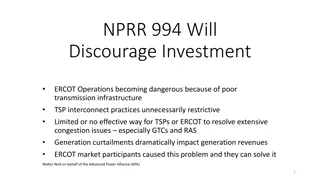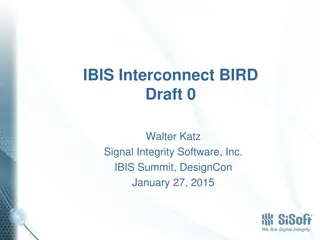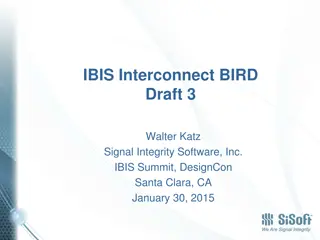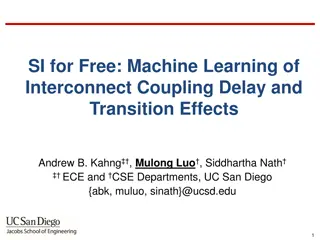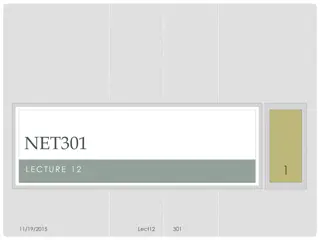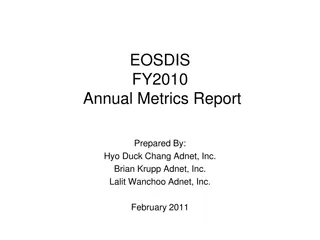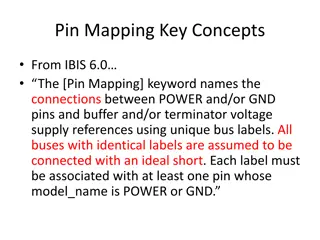Understanding Interconnect Topology Design and Performance Metrics
Interconnect topology design plays a crucial role in determining the cost and performance of a network. Factors such as the number of switches and links, switch port count, network layout, throughput, packet latency, average hop counts, nodal degree, hop count, and diameter are essential considerations in optimizing network performance and cost efficiency. Evaluating metrics such as nodal degree, hop count, and diameter helps in assessing network efficiency and latency. Perfect routing and flow control assumptions aid in evaluating performance metrics accurately.
Download Presentation

Please find below an Image/Link to download the presentation.
The content on the website is provided AS IS for your information and personal use only. It may not be sold, licensed, or shared on other websites without obtaining consent from the author. Download presentation by click this link. If you encounter any issues during the download, it is possible that the publisher has removed the file from their server.
E N D
Presentation Transcript
Interconnect Topology First step in the interconnect design. Topology design determines the cost of the network and significantly impact the performance: o number of switches and links o the switch port count (nodal degree) o network layout o Bound the throughput and packet latency Average hop counts decide the latency
Performance: Network offered load .vs. average package latency Minimal latency bounded by topology and routing and flow control Average package latency Minimal latency bounded by topology and routing Minimal latency bounded by topology Offered load (packet generation rate)
Performance: Network offered load .vs. average package latency Max throughput bounded by topology and routing and flow control Average package latency Max throughput bounded by topology and routing Max throughput bounded by topology Offered load (packet generation rate)
Topology design/performance metrics Metrics for evaluating the performance and cost of a topology. Assumptions: o Perfect routing (perfectly balanced load) o perfect flow control (no idle cycles in any link or channel)
Metric: nodal degree Nodal degree: how many links connect to each node. o Relates to cost or complexity of the implementation o Higher degree means larger port count for each switch. Degree = 2 Degree = 4
Metric: Hop count and Diameter Path: an ordered set of links from source to destination Hop count: number of hops in the path from source to destination o Minimal hop count: the hop count for the shortest path from source to destination o proxy for latency Diameter: the largest minimal hop count among all source destination pairs in the network Average minimum hop count: average across all source destination pairs Routing may use longer paths, which will increase the hop count. src dst 3 hops from source to destination.
Diameter and Average minimum hop count example Diameter = ? Average minimum hop count =
Maximum channel load and bisection bandwidth Maximum link(channel) load is defined with respect to the packet injection rate (from each node) and a traffic pattern (e.g. random uniform traffic). A link load of 2 means that the link is loaded with twice the injection bandwidth o If a node injects 1 flit per cycle, 2 flits will want to use the link (which can only send 1 flit in on cycle). o If the bottleneck link can only send 1 flit each cycle (this is usually the definition of cycle ), then the network bandwidth is of the link bandwidth.
Maximum link load example F B A E H D G C Maximum link load with random uniform traffic o Each packet from every node has an equal probability to go to any other node. Bottleneck link (D, E). Half of the traffic from nodes A, B, C, D must go through the link o4 1 2= 2 Network saturates at injection bandwidth.
Bisection bandwidth Cut: A cut partitions all nodes into two disjoint sets. Bisection: o Bisection is a cut that divides all nodes into half or nearly half. o Link (channel) bisection: counting the link in the bisection. Bisection bandwidth: The smallest bandwidth between any half of the nodes to another half of the nodes. o proxy for aggregate throughput Routing and flow control can have significant impact Using bisection bandwidth has an implicit assumption of ideal routing (completely load balanced) and ideal flow control. With uniform random traffic o of the traffic will cross the bisection in one direction. o in two directions.
Bisection bandwidth examples F B A E H D G C
Bisection bandwidth examples Not the smallest cut, not a bisection
Metric: path diversity Path diversity oNumber of shortest (or short) paths between a pair of nodes oMultipath routing utilizes and exploits path diversity oFault tolerance
Interconnection network types Direct o Each switch (router) is associated (or connected) to a compute node (or terminal node) o All switches (routers) are sources and destinations of traffic o Examples: ring, mesh. When drawing such topology, switch and compute nodes are sometime merged in a graph. Indirect o Switches are distinct from compute/terminal nodes o Compute nodes can be sources and destinations of traffic o Switches do not generate traffic o Example: bufferfly network
Direct and indirect network examples Direct: switch and compute nodes are together Indirect network
Regular and irregular topology Regular topologies oNodes are connected with some kind of patterns. The graph has a structure. oNodes are identified by coordinates. oRouting can usually pre-determined by the coordinates of the nodes. Irregular topologies oNodes are connected arbitrarily. The graph does not have a structure, e.g. internet More extensible in comparison to regular topology. oUsually use variations of shortest path routing. Which has better topology extensibility?
Linear array and ring Linear array Ring (torus) Short wire torus For a linear array or a ring with N nodes, what are the diameter, nodal degree, and bisection bandwidth?
Describing linear array and ring Array: nodes are numbered from 0, 1, , N-1 oNode i is connected to node i+1, 0 <= i <= N-2 Ring: nodes are numbered from 0, 1, , N-1 oNode I is connected to node (i+1) mod N, for all 0 <= i <= N-1
Multidimensional Meshes and Tori 2D torus Let the sizes of a d-dimensional mesh/torus be ?0, ?1, , ?? 1,each node in the topology can be represented by a d-dimension vector (?0, ?1, , ?? 1), 0 ?? ?? Which nodes does (?0, ?1, , ?? 1) connect to? Mesh: Diameter = ? Nodal degree = ? Bisection bandwidth = ? Torus: Diameter = ? Nodal degree = ? Bisection bandwidth = ?
Hypercubes 111 011 110 010 101 100 001 000 Also called Binary n-cube: n dimensions, the size of each dimension is 2. Each node is represented by a binary number. o A link between two nodes whose binary numbers differ by 1 bit. Diameter ? Nodal degree? Bisection bandwidth?
K-ary n-cube (n-dimensional, size of each dimension is k) Generalized from hypercube (from binary (hypercube) to k-ary) n dimensions, each dimension has k elements Each node is identified by a n-digit k-based number. 4-ary 0-cube 4-ary 1-cube 4-ary 2-cube 4-ary 3-cube
Tree Fixed degree. Diameter? Bisection bandwidth?
Summary Array Ring d-dimension torus Hypercube ? = 2? k-ary n-cube ? = ?? Tree # of nodes N N N ? = ?0 ?? 1 2d degree 2 2 ? 2 2 2n = 2????(?) ?(? 1) ? = log(?) 3 ?0+?1+ +?? 1 2 diameter N-1 ? = log(?) 2log(?) ??) =O( ? 2 ? ?= ?? 1 2 ?0 ?1 ?? 1 max{?0, ,?? 1} Bisection band. 1 1
Irregular topology Irregular topology does not any special mathematic properties oCan be expanded in any way. oNo easy way for routing: routes need to be computed like in the Internet. Routes can usually be determined in a regular network by using the coordinates of the source and destination. oHow to compute nodal degree, diameter, and bisection bandwidth of a irregular topology?
Indirect networks Compute nodes are not directly attached to each switch, but are rather attached to the whole network. oUsing a central interconnect to connect all compute nodes oThe network emulate the cross-bar switch functionality. oCurrently dominates in data centers.
Fully connected network Different organizations: Connected by one crossbar switch, connecting all nodes, connected with a crossbar. All permutation communication (each node sends one message and receives one message) can be realized.
Multistage network Try to emulate the cross-bar connection. Realizing permutation without blocking Using smaller cross-bar(2x2, 4x4) switches as the building block. Usually O(Nlg(N)) switches (lg(N) stages.
Butterfly network Basically realize the hypercube pattern. Nodes are numbered as binary numbers 4 stages for 8 node network: o 0-1 stage: identity + first dimension connectivity. E.g. 011-> (011, 111) o 1-2 stage: identity + second dimension connectivity connectivity. E.g. 011-> (001, 011) o and so on. path from 001(at level 0) to 110 (level 3)?
Butterfly network path from 001(at level 0) to 110 (level 3)? o001 -> 101 -> 111->110 Path from 000 (at level 0) to 010 (level 3)? Butterfly network is blocking since cannot realize all permutations. E.g. 000->010 and 100->011. o Notice that from a source (at level 0) to a destination (at level 3), there is a unique path.
Benes network Two copies of Butterfly networks, 2NLogN switches. Benes network is rearrangably nonblocking by rearranging the flows, all permutations can be realized without contention. oThis is mathematically proven in the 60s . o Consider 000->010 and 100->011
Clos network Three stages: ingress stage, middle stage, and egress stage Ingress/egress stage has r n X m switches Middle stage has m r X r switches Each switch at ingress/egress stage connects to all m middle switches (one port to each switch).
Clos network Theory: Clos network is strict sense non-blocking when m>=2n-1. Strict sense non-blocking: when a new flow is added to an existing permutation, the new flow can be routed without changing existing flows. Proof: when setting up a new flow, the source switch will at most has n-1 flows, which are routed to n-1 middle switches. Similarly, the destination switch will at most has n-1 flows. Hence, existing flows will at most use 2n-2 middle switches.
Fat tree Plain tree topology has a bottleneck at the root. Fatter links (bundling more of links together) as we go up, so bisection BW scales with N o Not practical, root is an NxN switch
Practical Fat-tree Use smaller switches to approximate large switches. Connectivity is reduced, but the topology is now implementable Most commodity large clusters use this topology. Also call constant bisection bandwidth network (CBB)
Fat-tree and Folded Clos network A generic 2-level fat-tree (folded Clos) A generic 3-stage Clos network
Recent designs Low diameter topology with high-radix switches oDragonfly (diameter = 3), Slimfly (diameter = 2), Megafly, HyperX Dragonfly topology: oTwo-level topology oA set of a switches forming a group. A group is like a mega router. oThe switches within one group is connected by fully connected topology oEach router is connected with p processing nodes oEach router has h links (global links) connecting to other groups.
Dragonfly network Left side shows a Dragonfly formed by 7- port switches. o each group has 4 switches o 9 groups What is the largest Dragonfly that can be built with 23 port switches with a group size of 12 and 6 compute nodes connecting to each switch? Each switch has 23-11-6 = 6 global links.
Physical constraint on topologies Number of dimensions. 2 or 3 dimensions Can be layout physically Short wires, easy to build Many hops, low bisection bandwidth >=4 dimensions Harder to build, longer wires Fewer hops, better bisection bandwidth K-ary n-cubes provide a good framework for comparison.














